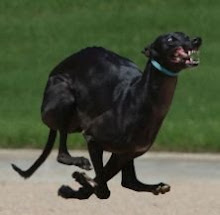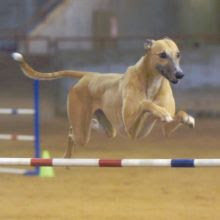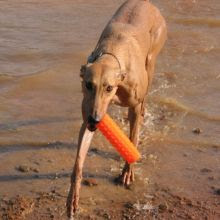
Hiking with Riley has reminded me how wonderful a prong or pinch collar can be. Most people would never consider a prong collar to be an option for our thin skinned greyhounds. However, if you have been hurt because your dog has pulled you off your feet.... if you do not enjoy walking your dog (even small dogs) because of the constant pulling or unexpected lunges.... if other animals are at risk because you are out of control, then a prong collar may just be your new best friend.
A prong collar basically gives you some leverage so you do not have to struggle and wrestle with your dog. I liken it to whispering. I would much prefer my dog to respond to gentle leash guidance than to feel like I am tugging, yanking, and manhandling my dog with a flat collar. Most dogs will "yip" the first time they lunge hard. They aren't expecting to feel the the pinch and are surprised by it. In cruel, insensitive hands a prong collar could do damage, but in gentle hands I have yet to see a dog pull so hard to cause injuries.

In my opinion, prong collars are not a substitute for good training. With few exceptions, I do not train with a prong collar. I aim to always be consistant so when my dog wears a flat collar, I do not allow any pulling and will issue a distance penalty each time. A distance penalty is backing up in the opposite direction and making the dog change direction. It can be tedious, but it pays off after a few weeks. When I do not have time to insist on good manners, a prong collar gives me a time out so we can just walk. Its very easy for a dog to tell the difference between a prong and a flat collar so there is no confusion.
A fitted prong collar should sit above the regular ID collar. A prong collar should not look like a necklace draped around the dog's neck. The collar is made up of links that can be added or subtracted to custom fit it to your dog's neck. I prefer the small sized links for greyhounds.
A prong collar basically gives you some leverage so you do not have to struggle and wrestle with your dog. I liken it to whispering. I would much prefer my dog to respond to gentle leash guidance than to feel like I am tugging, yanking, and manhandling my dog with a flat collar. Most dogs will "yip" the first time they lunge hard. They aren't expecting to feel the the pinch and are surprised by it. In cruel, insensitive hands a prong collar could do damage, but in gentle hands I have yet to see a dog pull so hard to cause injuries.

In my opinion, prong collars are not a substitute for good training. With few exceptions, I do not train with a prong collar. I aim to always be consistant so when my dog wears a flat collar, I do not allow any pulling and will issue a distance penalty each time. A distance penalty is backing up in the opposite direction and making the dog change direction. It can be tedious, but it pays off after a few weeks. When I do not have time to insist on good manners, a prong collar gives me a time out so we can just walk. Its very easy for a dog to tell the difference between a prong and a flat collar so there is no confusion.
A fitted prong collar should sit above the regular ID collar. A prong collar should not look like a necklace draped around the dog's neck. The collar is made up of links that can be added or subtracted to custom fit it to your dog's neck. I prefer the small sized links for greyhounds.
















